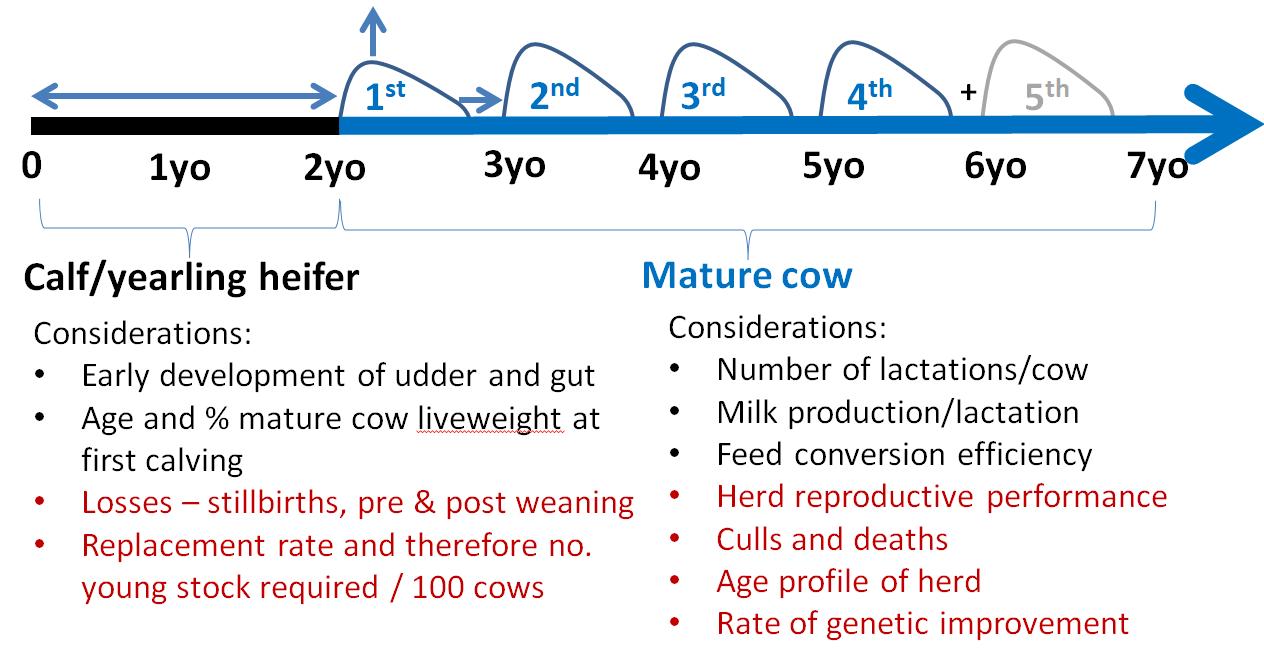
2 minute read
8. Lifetime production efficiency
Key points: Many factors related to the milking herd and the replacement herd contribute to lifetime production efficiency of a whole herd Jerseys have demonstrated advantages in grazing systems, longevity, productive life, calving ease, reproduction, heat stress and hybrid vigour contribution. However, Holsteins offer different various benefits in each production system A modelling approach may therefore be more appropriate and useful when comparing lifetime efficiency of Jerseys and Holsteins within a given production system
At a herd level, considering all animals on a farm, there are many factors which contribute to lifetime production efficiency, as expressed as the percentage of total megajoules of metabolisable energy eaten that is used for productive purposes i.e. producing milk (Figure 22). Improved performance in any of these factors will therefore help to improve lifetime production efficiency. For example, considering the number of lactations per cow, Garnsworthy (2014) calculated that if a cow that had completed three lactations went on to complete a fourth lactation, its lifetime energetic efficiency (NE milk/ ME intake) was increased by 8%. Of course, improved performance in any of these factors will also help to reduce a herd’s environmental footprint with respect to greenhouse gas (GHG) emissions (DeVries et al., 2020). Reductions in water use and nitrogen use may also be realised.
Advertisement
Figure 22. Lifetime production efficiency of the whole herd (inc. young stock). [Little, 2014].
One of the earliest farmlet studies that compared the performance of Holsteins and Jerseys conducted in New Zealand was reported by Grainger and Goddard (2004). First year results suggested that net income was greater for Jerseys, but in later years of the study the results showed that Holsteins were the more profitable breed. Numerous comparative breed studies in Ireland have been reported since and while each breed has its benefits, the lifetime efficiency and most profitable breed is often in dispute depending upon production system (confinement or grazing), stocking rate, season, milk prices, etc. [Prendiville et al., 2009; Coffey et al., 2016]. Nevertheless, many of these studies show the heterosis benefit of the Holstein X Jersey crossbred [Prendiville et al., 2009; Coffey et al., 2016].
The efficiency and profitability of Holstein and Jersey cows has been scrutinized, compared, and debated for many years. Carstensen (2013) reviewed the literature of numerous studies relating to Holstein and Jersey efficiency and profitability to determine if a breed advantage existed in any or all related areas. Jerseys were found to demonstrate breed advantages in grazing systems, longevity, productive life, calving ease, reproduction, heat stress under normal
conditions, and hybrid vigour contribution [Carstensen, 2013]. Overall, breed differences and interactions were discovered in every area examined. While Jerseys excelled in a greater number of areas, Carstensen (2013) concluded that an overall advantage was difficult to discern due to the various benefits offered by both breeds.
Where there are diverse dairy production systems, the various breeds of dairy cows each have their own characteristics that may contribute to their lifetime productive efficiency in each system. The relative performance of various breed traits may differ depending upon the production system. It may therefore be more appropriate and useful when comparing Jerseys with Holsteins to use a modelling approach such as that used by Pyman et al. (2008) when they compared the performance of Holstein cows with Holstein X Jersey cross cows, so that all the different and various factors that contribute to lifetime efficiency can be taken into account for each breed. Of course, the outcomes of any modelling study are highly dependent on the assumptions used.









